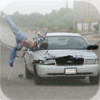Pedestrian Reconstruction
Detailed App Info:
Application Description
The Pedestrian Reconstruction program is a compressive collision reconstruction application for pedestrian involved collisions.
The application has been set up to be as user friendly as possible while being equally as comprehensive.
On the main/start up page the investigator is presented with a series of questions asking for the data they have. When the investigator selects “Yes” to any of the data elements, the related text field unlocks, allowing the data entry. In addition to the data fields, there are a series of Yes/No style questions used to determine which pedestrian equations are to be completed.
After the appropriate data has been entered, the View Results option is selected.
On the results screen the various pedestrian equations are displayed by author’s name:
•Appel
•Aronberg and Snider
•Barzeley
•Casteel
•Eubanks
•Eubanks Fall and Slide
•Fugger and Randles
•Kuhnel
•Limpert
•McHenry Fall and Slide
•Northwestern
•Pultar
•Rich
•Schmidt and Nagel
•Searle
•Searle New
•Stcherbatcheff
•Sturtz
•Wood
•Wood New
When taking into account those authors that dictate a high and low value, 39 possible equations are evaluated by the application.
Each equation will display its result in both fps and mph, or m/s and km/h. If an equation has not been calculated it will display “N/A” for the results along with the reason it could not be calculated.
At the top of the result screen the average value of all of the equations is displayed, along with the high and low values, both identified by the equation producing the value.
Swiping down on the result screen, displays additional results along with a pedestrian trajectory analysis. Below these calculations is an option to display all of the pedestrian equation calculations in a step-by-step or line-by-line fashion.
The results, to include the line-by-line calculations may be emailed, allowing the data to be copied and pasted into any word processing program.
In addition to the results, there is a screen providing detailed information for each of the equations. There is a second view showing a table displaying the variable requirements of each equation. And a third displaying detailed information for each of the equation variables and information concerning the operation of the program.
For those who are familiar with my Pedestrian Equations for Excel, I have tried to reproduce the functionality of that program, along with many of its features into this application.
The application has been set up to be as user friendly as possible while being equally as comprehensive.
On the main/start up page the investigator is presented with a series of questions asking for the data they have. When the investigator selects “Yes” to any of the data elements, the related text field unlocks, allowing the data entry. In addition to the data fields, there are a series of Yes/No style questions used to determine which pedestrian equations are to be completed.
After the appropriate data has been entered, the View Results option is selected.
On the results screen the various pedestrian equations are displayed by author’s name:
•Appel
•Aronberg and Snider
•Barzeley
•Casteel
•Eubanks
•Eubanks Fall and Slide
•Fugger and Randles
•Kuhnel
•Limpert
•McHenry Fall and Slide
•Northwestern
•Pultar
•Rich
•Schmidt and Nagel
•Searle
•Searle New
•Stcherbatcheff
•Sturtz
•Wood
•Wood New
When taking into account those authors that dictate a high and low value, 39 possible equations are evaluated by the application.
Each equation will display its result in both fps and mph, or m/s and km/h. If an equation has not been calculated it will display “N/A” for the results along with the reason it could not be calculated.
At the top of the result screen the average value of all of the equations is displayed, along with the high and low values, both identified by the equation producing the value.
Swiping down on the result screen, displays additional results along with a pedestrian trajectory analysis. Below these calculations is an option to display all of the pedestrian equation calculations in a step-by-step or line-by-line fashion.
The results, to include the line-by-line calculations may be emailed, allowing the data to be copied and pasted into any word processing program.
In addition to the results, there is a screen providing detailed information for each of the equations. There is a second view showing a table displaying the variable requirements of each equation. And a third displaying detailed information for each of the equation variables and information concerning the operation of the program.
For those who are familiar with my Pedestrian Equations for Excel, I have tried to reproduce the functionality of that program, along with many of its features into this application.
Requirements
Your mobile device must have at least 1.74 MB of space to download and install Pedestrian Reconstruction app. Pedestrian Reconstruction is available on iTunes for $24.99
If you have any problems with installation or in-app purchase, found bugs, questions, comments about this application, you can visit the official website of Accident Analysis and Reconstruction, Inc Charles Russell at http://aarecon.com.
Copyright © C. Gregory RUssell





